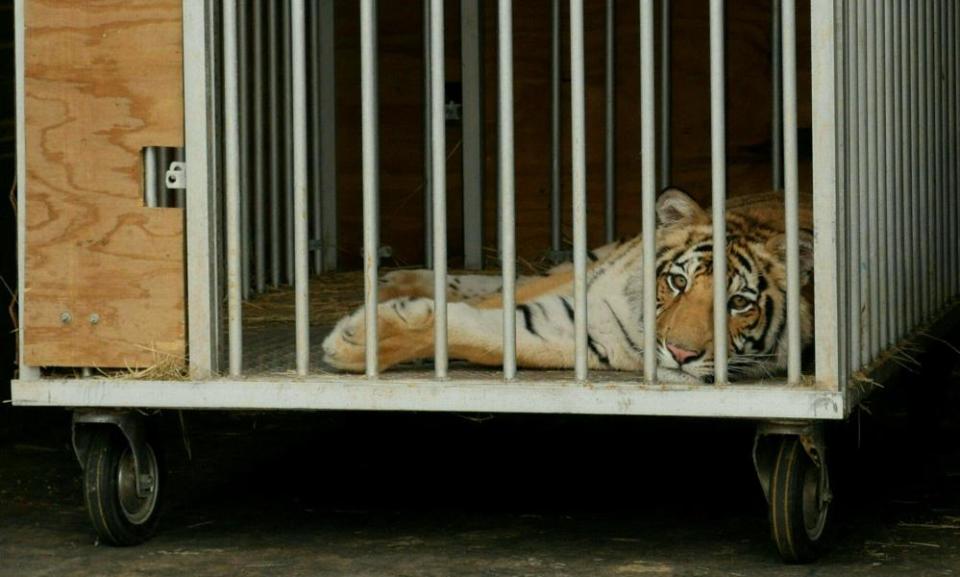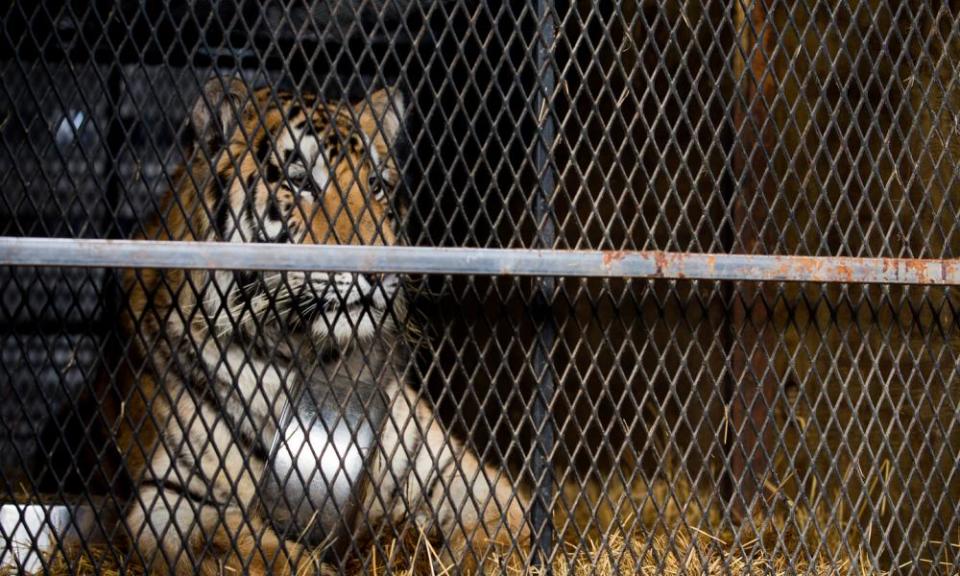Tiger trafficking: the murky world of America’s big-money big cat trade

The first red flag was the shiny Chevy Camaro with no license plate.
“Anything to declare?” asked the US Customs and Border Protection officer.
Related: Animals from Tiger King Park will be handed to US government
“Nothing,” replied the 18-year-old driver, Luis Eudoro Valencia, a native of the tiny desert town of Perris, California.
It was 1.30am on 23 August 2017, at the Otay Mesa port of entry, right where Mexico becomes California. The 24-hour crossing, one of three linking Tijuana and San Diego, is the border’s busiest commercial point, full of semis and flatbeds.
With such heavy cover, maybe Valencia thought he could slip through.
A tagless Chevy probably didn’t scream much beyond negligent driver – that is, until an officer shone a flashlight on the man riding shotgun, 21-year-old Eriberto Paniagua, and an orange ball of fur darted between his legs.
“It’s just a cat,” Paniagua explained.
At six pounds, it may have weighed the same as a tabby, but it didn’t look like it. Minutes later, the officers had found a six-week-old Bengal tiger cub sitting in the front passenger footwell. A tiger.
Paniagua produced AeroMexico Cargo paperwork, even a sales receipt stating tigers aren’t a protected species (tigers are endangered and illegal to import to the US and in any of the 175 nations that prohibit the international trade in threatened species).
Valencia claimed he just wanted an exotic pet, and then shifted gears, admitting to having paid $300 to a Tijuana man he saw walking an adult tiger on a leash.
The story quickly got weirder.
Scrolling his photo roll and text messages, officers saw it wasn’t a one-off: there were shots of monkeys, jaguars, lions. Valencia was a teenage wildlife trafficker.
The men were arrested and the Camaro impounded – but after the officers plopped the ball of fur into a cardboard box, they put their heads together and wondered: what do we do with the cub?
‘So many big cats in the US disappear’
There are about 10,000 tigers in the US – more in Texas alone than in India. Thirty states allow private ownership of predatory exotics like tigers. The requirements are deceptively simple: a USDA conservation label form and a $30 license. Nine states require no permit or license whatsoever. This allows virtually anyone to own, breed and sell tigers.
Most of the trade is grounded in a high demand for tiger bones and products popular in the traditional Chinese medicine market – which is how I end up in Colorado, stepping through the 22,000-square-foot National Wildlife Property Repository, a mausoleum of 1.3m confiscated animal products.
Shelves of mounted tigers, skins, medicinals, gold tooth earrings, claw necklaces, skulls unfold in front of me – the scene is eerily reminiscent of the final scene from Raiders of the Lost Ark.
This is just the tip of the iceberg, says Sarah Metzer, a US Fish and Wildlife Service education specialist. “What you’re seeing is maybe 10% of all of the seized goods from US ports of entry.” She pushes aside a zebra skin chaise longue to open a loading dock door. “There’s so much contraband we’re running out of space.”
Metzer heads a skeleton crew that catalogues, stores and loans items to academics and federal agencies for training, even field work. The tiger skin in front of me could be used in a sting operation. With only 120 wildlife inspectors nationwide, USFWS leans heavily on the border patrol and other law enforcement.
Passing a leopard coat, Metzer crouches by a moth-eaten Bengal tiger head and a snarling cub forever frozen by a taxidermist.
“This is a tiger fetus someone was trying to sell online,” she says, sober as an undertaker. “If there’s money to be made off of these animals, it doesn’t matter what form they’re in, there will be folks trying to meet that demand.”
I ask if captive US tigers are smuggled overseas, and Metzer says there’s no way wild tigers alone support this trade. She leads me to an aisle housing thousands of organ and bone medicinals – all tiger. “Every part of the tiger is incorporated in some type of traditional medicine, and as a social status symbol,” she says.
Scientific studies show these products contain no medicinal properties. The Chinese government admits as much, yet permits the goods as long as they’re from farmed animals.
“When you think about the financial value of the bones of adult tigers, it’s huge,” says John Goodrich, the chief scientist of Panthera, one of the leading big cat NGOs. “That’s the cause of this huge black market.”
With so many of the animals in the US, is it then fair to speculate that tigers from Texas end up as byproducts in Beijing?
“So many big cats in the US disappear,” says John R Platt, the editor of the Revelator, the media partner of the Center for Biological Diversity. “I would not be surprised if US tigers were turning up in China.”

While listed as “endangered” under the federal Endangered Species Act, the law allows private possession of captive-bred tigers as long as they’re used for “conservation”, but experts say no tigers bred in captivity are ever released. In 1900, there were about 100,000 tigers in the wild. Today, about 4,000 remain in a handful of nations. If none return to the wild, how does private possession of the feline benefit the species?
“It doesn’t,” says Nicole Paquette, the Humane Society’s chief programs and policy officer. “Public contact with big cats fuels every component of the trade.”
That trade includes everything from Instagram-ready roadside zoos to six-figure tiger skin rugs, as well as tiger bone wines that run to hundreds of dollars a bottle made from steeping a carcass in rice wine, then ageing it. Boiling, grinding and mixing bones with herbs forms a glue-like plaster, all of which requires a steady supply of parts, which experts say is probably coming from farmed tigers in Asia and America.
Wildlife traffickers use the same routes as narco traffickers, says Andrea Crosta, the head of Earth League International, an NGO using counter-surveillance to fight wildlife crime.
In South America, Crosta has documented poached jaguar teeth and bones shipped to China and passed off as tiger, another corollary to the trade affecting other species. “It’s easy to transport, you just put the fangs in your pocket and go on a plane. Jaguar canines in South America go for $200 to $300 – you can sell it in China as tiger for $5,000 to $10,000. You make real money.”
Border cub’s next steps
Otay Mesa’s border cub now weighs more than 300 pounds and could easily rip off your arm if you tried to pet him. We meet in the mountains east of San Diego, near Cleveland national forest.
Lions, Tigers and Bears, the nonprofit that took the cub in, is purposely hard to reach, with dirt roads and a spread that resembles an Old West version of Jurassic Park; I can make out the stalking silhouettes when I pull up.
Bobbi Brink, who started the sanctuary in 2002, greets me in a golf cart. I wedge beside her as we zoom by paddock after paddock – bobcats, pumas, leopards, bears, all victims of abuse and trafficking. The fences are high for a reason.
We stop at the sprawling enclosure of the cub she baptized Moka, meaning “chance” in Bengali. Life behind bars here is as free as he could ever hope for.
Moka rises and stretches, muscles rippling under bright orange fur. Farmed tigers are usually better-fed and better-looking. Brighter coats drive up prices, meaning that in a strange twist, wild tigers are worth less.
I can’t help thinking about the Netflix phenom Joe Exotic. The Oklahoma zookeeper, dubbed the Tiger King, was convicted of a murder-for-hire plot against a Tampa animal sanctuary owner, falsifying wildlife records and violating the Endangered Species Act after he sold cubs to pay for the killing.
Leigh Henry, from the World Wildlife Federation, called Tiger King a missed opportunity. “I would have hoped a show like that, with such a large viewership, would highlight the issue of captive tigers in the US,” she said. “We’ve been working for 15 years to try to get the US to clamp down, but everything is up in the air because of Covid.”
A captive tiger lives about 20 years and costs $10,000 annually for food and care – which is why cubs are more valuable. Grown up, they’re hard to manage and less lucrative. Adopters with good intentions but little training do not know what they’re getting into when they fork over $500 for a cub. A baby Moka can star on social media for an $80 photo op at an ersatz zoo or petting venues that claim to breed tigers but in fact encourage trafficking.
“If you cuddle or take a selfie with a tiger, you’re in a facility with no conservation value and they very well could be selling the body parts out the back door,” Debbie Banks, the tiger lead at the Environmental Investigation Agency, tells me when I raise the issue a few days after my visit to the sanctuary.
Dozens of dead tigers in freezers
Sketchy rules have another price: more than 700 recorded big cat maulings and deaths in the US. In one incident, known as the Zanesville Massacre, a mentally disturbed Ohio man freed 56 tigers, lions, bears and wolves before killing himself. Police tracked and killed most of the animals, and Ohio has banned dangerous exotics as pets.
In 2019, the Illinois representative Mike Quigley introduced the Big Cat Public Safety Act, which would outlaw all big cat ownership (the bill has since been reintroduced in the Senate).
Without public records, numbers and locations remain unknown. “Not enough people talk about this,” says Quigley, whose office has found 77 facilities offering tiger cubs for sale. “There’s no central tiger database. And I’m not the only one asking ‘where have all these big cats gone?’”
Killing these animals for profit, selling hides, parts or meat are illegal; and it’s illegal to sell cats across state lines. Yet it can be legal within a state, based on individual law.
Take California. Of the 260 US Department of Agriculture-licensed exhibitors there, about 20 are accredited by the Association of Zoos and Aquariums. With so many Hollywood trainers, theme parks, private menageries, roadside zoos and pseudo-sanctuaries, California ranks third nationwide in dangerous big cat incidents.
The market is huge, but the penalties aren’t.
Cubs like Moka aren’t one-offs, says Phillip Land, a special agent in the USFWS office of law enforcement on the southern border. “In Brownsville, Texas, they tried to smuggle a tiger cub in a trash bag across the border. They basically dumped him on the side of the river. Border patrol found it and called us,” he says.
And in 2005, a breeder in Colton, California, was convicted of child endangerment and animal cruelty after authorities found 11 tiger and leopard cubs in his attic, two tigers on the porch, 58 dead tiger cubs in a freezer, and about 30 dead tigers decomposing on the property.
The public may consider these offenses relatively insignificant, but Land tells me it’s often the same gangs at play as in other offenses. And with so much money, few regulations and a healthy pipeline, the problem isn’t going away.
The hunter-turned-conservationist Jim Corbett once said: “the book of nature has no beginning, as it has no end.” A century later, with the species on the brink just to make a medicinal wine that doesn’t even work, or to binge-watch a show before we all move on to the next hit, the haunting question remains: is this the new law of the jungle?

 Yahoo Finance
Yahoo Finance 